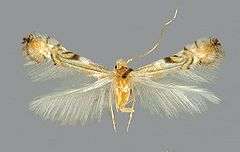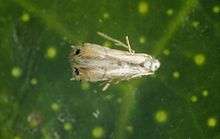Phyllocnistis
| Phyllocnistis | |
|---|---|
 | |
| Phyllocnistis maxberryi | |
| Scientific classification | |
| Kingdom: | Animalia |
| Phylum: | Arthropoda |
| Class: | Insecta |
| Order: | Lepidoptera |
| Family: | Gracillariidae |
| Subfamily: | Phyllocnistinae |
| Genus: | Phyllocnistis Zeller, 1848 |
| Species | |
|
See text | |
Phyllocnistis is a genus of moths in the family Gracillariidae.
Description
Adult
Adults of the genus Phyllocnistis are very small moths with wingspans generally not exceeding 5 mm. Both fore- and hindwings are lanceolate and predominantly white. The forewings are marked with yellow to orange, longitudinal and oblique striae, often bordered by gray or black. A few species are known to possess much darker or strikingly color patterns. The compound eyes of Phyllocnistis are reduced, with an interocular index (vertical eye diameter/minimum interocular distance) of approximately 0.9. The maxillary palpi are the most reduced among Gracillariidae, being barely evident as vestigial, non-segmented lobes at the base of the elongate proboscis. The wing venation is also reduced.
Larvae
The larvae of Phyllocnistis are among the most specialized Lepidoptera. Four instars appear to be the norm, with the first three instars possessing a sapfeeding morphology and behavior. Sapfeeding instars create a long serpentine, subepidermal mine on either the upper or lower surfaces of the host leaf. A few species also form subepidermal mines on stems and various fruits, including avocado. A characteristic, median frass trail extends the length of the mine, usually as a dark, unbroken line. The fourth instar is a highly specialized, apodal, non-feeding instar whose primary function is to spin the cocoon, at the mine terminus, prior to pupation.
Pupae
In contrast to the conservative morphology of the larval and adult stages, the pupae of Phyllocnistis are structurally diverse, particularly with regard to the development of the frontal process (cocoon-cutter) of the head. In addition, the mid-dorsal areas of abdominal terga 3–7 possess a mostly symmetrical cluster of recurved spines that frequently differ in their arrangement and form among species.[1]
Ecology
Phyllocnistis can be found on many host plants, and have been noted on plants from at least 20 families.[2] One well-known species is the citrus leafminer (Phyllocnistis citrella), a pest of plants in the family Rutaceae, especially citrus.[3]
Species
As of 2012, about 126 Phyllocnistis species have been described. This is probably a fraction of the true diversity of the genus, especially in the tropics, where there may be hundreds of species yet to be collected.[2]

- Phyllocnistis abatiae E. M. Hering, 1958
- Phyllocnistis acmias Meyrick, 1906
- Phyllocnistis ampelopsiella Chambers, 1871
- Phyllocnistis amydropa Meyrick, 1934
- Phyllocnistis argentella (Bradley, 1957)
- Phyllocnistis argothea Meyrick, 1933
- Phyllocnistis atractias Meyrick, 1906
- Phyllocnistis atranota Meyrick, 1906
- Phyllocnistis aurilinea Zeller, 1877
- Phyllocnistis baccharidis E. M. Hering, 1958
- Phyllocnistis bourquini Pastrana, 1960
- Phyllocnistis breynilla Liu & Zeng, 1989
- Phyllocnistis canariensis M. Hering, 1927
- Phyllocnistis cassiella Ghesquière, 1940
- Phyllocnistis chlorantica Seksyaeva, 1992
- Phyllocnistis chrysophthalma Meyrick, 1915
- Phyllocnistis cirrhophanes Meyrick, 1915
- Phyllocnistis citrella Stainton, 1856
- Phyllocnistis citronympha Meyrick, 1926
- Phyllocnistis cornella Ermolaev, 1987
- Phyllocnistis diaugella Meyrick, 1880
- Phyllocnistis dichotoma Turner, 1947
- Phyllocnistis diplomochla Turner, 1923
- Phyllocnistis dorcas Meyrick, 1915
- Phyllocnistis drimiphaga Kawahara, Nishida & Davis, 2009
- Phyllocnistis echinodes Meyrick, 1926
- Phyllocnistis embeliella Liu & Zeng, 1989
- Phyllocnistis endoxa Meyrick, 1926
- Phyllocnistis ephimera Turner, 1926
- Phyllocnistis eurymochla Turner, 1923
- Phyllocnistis exaeta Meyrick, 1926
- Phyllocnistis exiguella van Deventer, 1904
- Phyllocnistis extrematrix Martynova, 1955
- Phyllocnistis finitima Braun, 1927
- Phyllocnistis habrochroa Meyrick, 1915
- Phyllocnistis hagnopa Meyrick, 1920
- Phyllocnistis hapalodes Meyrick, 1906
- Phyllocnistis helicodes Meyrick, 1916
- Phyllocnistis humiliella van Deventer, 1904
- Phyllocnistis hyperbolacma (Meyrick, 1931)
- Phyllocnistis hyperpersea Davis and Wagner, 2011
- Phyllocnistis insignis Frey & Boll, 1876
- Phyllocnistis intermediella Busck, 1900
- Phyllocnistis iodocella Meyrick, 1880
- Phyllocnistis labyrinthella (Bjerkander, 1790)
- Phyllocnistis leptomianta Turner, 1923
- Phyllocnistis liquidambarisella Chambers, 1875
- Phyllocnistis liriodendronella Clemens, 1863
- Phyllocnistis longipalpa Davis and Wagner, 2011
- Phyllocnistis loxosticha Bradley, 1965
- Phyllocnistis lucernifera Meyrick, 1935
- Phyllocnistis magnatella Zeller, 1873
- Phyllocnistis magnoliaeella Chambers, 1878
- Phyllocnistis maxberryi Kawahara, Nishida & Davis, 2009
- Phyllocnistis meliacella Becker, 1974
- Phyllocnistis micrographa Meyrick, 1916
- Phyllocnistis minimella van Deventer, 1904
- Phyllocnistis nepenthae M. Hering, 1931
- Phyllocnistis nymphidia Turner, 1947
- Phyllocnistis oxyopa Meyrick, 1918
- Phyllocnistis perseafolia Davis and Wagner, 2011
- Phyllocnistis pharetrucha Meyrick, 1921
- Phyllocnistis phrixopa Meyrick, 1926
- Phyllocnistis populiella Chambers, 1875
- Phyllocnistis psychina Meyrick, 1906
- Phyllocnistis puyehuensis Davis, 1994
- Phyllocnistis ramulicola Langmaid & Corley, 2007
- Phyllocnistis rotans Meyrick, 1915
- Phyllocnistis saligna (Zeller, 1839)
- Phyllocnistis sciophanta Meyrick, 1915
- Phyllocnistis selenopa Meyrick, 1915
- Phyllocnistis sexangula Meyrick, 1915
- Phyllocnistis signata Meyrick, 1915
- Phyllocnistis spatulata Meyrick, 1928
- Phyllocnistis stereograpta Meyrick, 1934
- Phyllocnistis subpersea Davis and Wagner, 2011
- Phyllocnistis symphanes Meyrick, 1926
- Phyllocnistis synglypta Meyrick, 1918
- Phyllocnistis tectonivora Meyrick, 1936
- Phyllocnistis temperatior Meyrick, 1936
- Phyllocnistis tethys Moreira & Vargas, 2012
- Phyllocnistis titania Meyrick, 1928
- Phyllocnistis toparcha Meyrick, 1918
- Phyllocnistis triortha Meyrick, 1906
- Phyllocnistis triploca Meyrick, 1928
- Phyllocnistis tropaeolicola Kawahara, Nishida & Davis, 2009
- Phyllocnistis unipunctella (Stephens, 1834)
- Phyllocnistis valentinensis M. Hering, 1936
- Phyllocnistis vitegenella Clemens, 1859
- Phyllocnistis vitella Ermolaev, 1987
- Phyllocnistis vitifoliella Chambers, 1871
- Phyllocnistis voutei M. Hering, 1932
- Phyllocnistis wampella Liu & Zeng, 1985
- Phyllocnistis wygodzinskyi E. M. Hering, 1958
- Phyllocnistis xenia M. Hering, 1936
References
- ↑ Davis, D. R. and D. L. Wagner. (2011). Biology and systematics of the New World Phyllocnistis Zeller leafminers of the avocado genus Persea (Lepidoptera, Gracillariidae). ZooKeys 97, 39–73.
- 1 2 Brito, R., et al. (2012). A new species of Phyllocnistis Zeller (Lepidoptera: Gracillariidae) from southern Brazil, with life-history description and genetic comparison to congeneric species. Zootaxa 3582, 1–16.
- ↑ Heppner, J. B. Phyllocnistis citrella. EENY-38. University of Florida IFAS. Published 1998, revised 2013.
External links
| Wikimedia Commons has media related to Phyllocnistis. |

